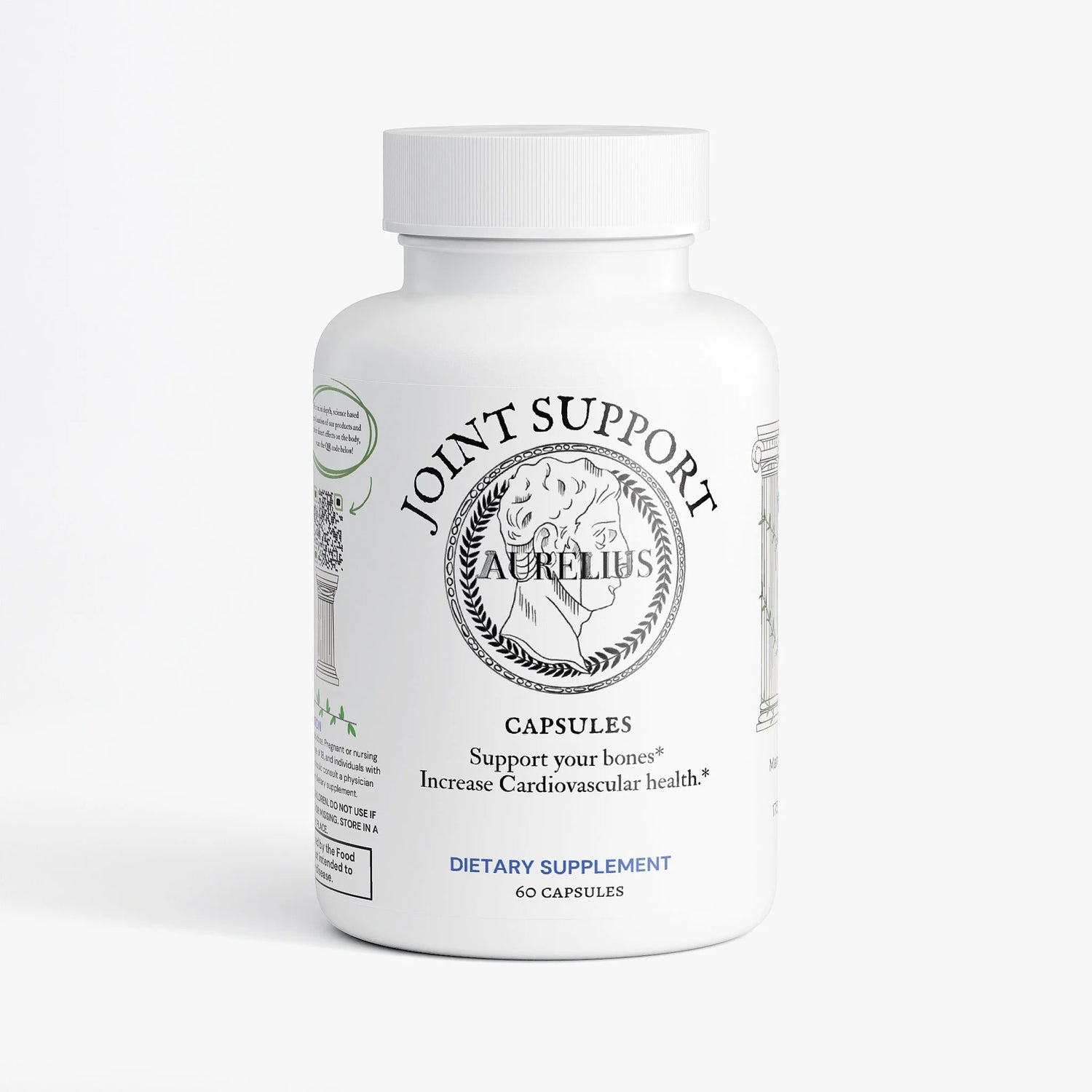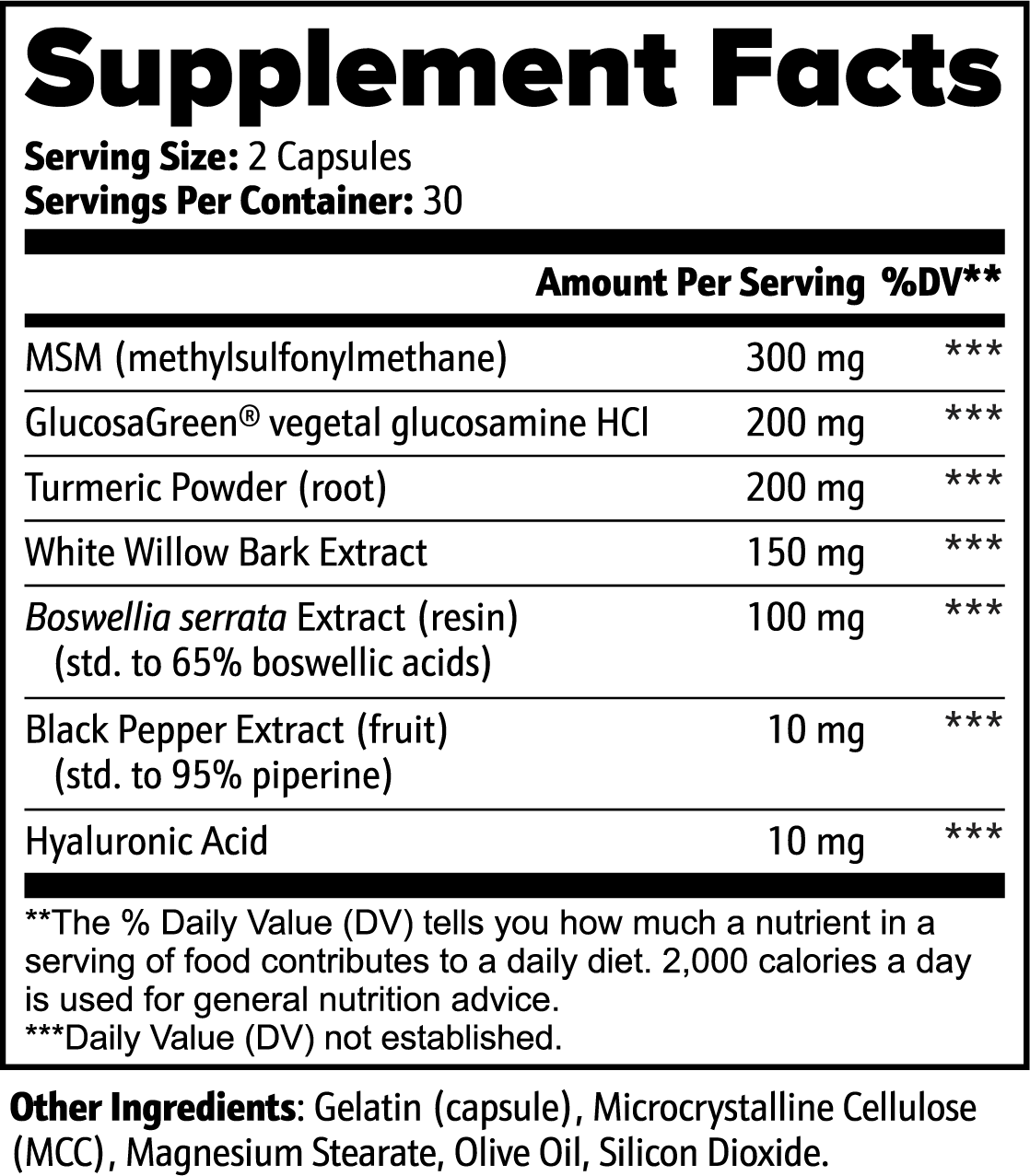
Joint Support
Strong joints are essential to a well structured body, this formulas ingredients are specifically for that. Recommended as a dietary supplement, adults take two (2) capsules daily. For best results, take with 6-8 oz of water or as directed by healthcare professional.

Key Ingredients:
-
MSM (Methylsulfonylmethane)
Purpose:
- Known for its anti-inflammatory and antioxidant properties, leading to its frequent uses for joint health.
- Studies show a decrease in soreness as well as reduced oxidative stress.
- Commonly used for Osteoarthritis relief, since MSM has shown to reduce pain, swelling, and stiffness.
- Also works as a great Antioxidant support for the body.
Where its Found:
- MSM can be found naturally in foods but in very small amounts. It can be found in various fruits, corn, tomatoes, tea, coffee, and milk.
- Also notably found in vegetables such as cabbage, broccoli, and brussels sprouts.
- As stated, the amounts of natural MSM are so faint they are often lost during processing or cooking.
-
GlucosaGreen vegetal glucosamine HCI
Purpose:
- Supports joint health via improving the health of your cartilage as well as reducing the overall pain.
- Glucosamine is a natural building block of cartilage and has shown to help reduce cartilage degrading and help in its rebuilding.
Where its Found:
- GlucosaGreen is fermented glucose that is turned into glucosamine.
- Notably a vegan and allergen free alternative to most shellfish derived glucosamine.
-
Turmeric Powder
Purpose:
- Contains a chemical called curcumin which may reduce swelling.
- It can also be used to treat depression, hay fever, and osteoarthritis.
- Very little is actually known about Turmeric but some small studies suggest that it may help with nonalcoholic fatty liver disease (NAFLD), osteoarthritis, and high cholesterol or other lipid disorders.
Where its Found:
- Turmeric is a spice that comes from the root of Curcuma longa.
- It is commonly found in tropical and subtropical climates, specifically in India and Southeastern Asia.
-
White Willow Bark Extract
Purpose:
- This extract is basically a painkiller because of the chemical called Salicin, which is similar to aspirin.
- The bark has been used for thousands of years as an anti-inflammatory, antipyretic, and analgesic.
- Is noted that the active ingredient is similar in makeup to Aspirin, so if you are allergic to Aspirin, it is advised you consult a health professional before taking this.
- The active ingredient salicin inhibits inflammations by down-regulating inflammatory mediators like tumor necrosis factor-α (TNF-α) and nuclear factor-kappa B (NF-κB).
Where its Found:
- The extract comes from Salix alba or European Willow trees.
- Native to Europe and parts of central & western Asia.
-
Boswellia serrata Extract
Purpose:
- Boswellia serrata decreases swelling and increases the body's immune response.
- Known to be used to combat Osteoarthritis and Rheumatoid arthritis because of its reduction o joint swelling, stiffness, and pain.
- Also seen to be used as a anti-inflammatory as well as a means to reduce muscles soreness and swelling.
Where its Found:
- A tree native to India, Africa, and the Arabian Peninsula, used in the traditional Indian medicine system, Ayurveda.
- One of the key ingredients is specifically the gum from the tree, and has been used for centuries.
-
Other Ingredients:
- Gelatin Capsule: Outer capsule made with gelatin to maintain the supplements capsule form.
- Microcrystalline Cellulose: A plant matter powder commonly used as a binder in pharmaceuticals.
- Magnesium Stearate: Commonly used to prevent the clumping of powders and is derived commonly from coconut or palm oil.
- Olive Oil: A natural oil derived from olives.
- Silicon Dioxide: Composed of silicon and oxygen atoms, it is used to ensure powder substances don't cake up overtime.
Sources
MSM:
Butawan, Matthew, et al. “Methylsulfonylmethane: Applications and Safety of a Novel Dietary Supplement.” Nutrients, vol. 9, no. 3, 16 Mar. 2017, p. 290, www.ncbi.nlm.nih.gov/pmc/articles/PMC5372953/, https://doi.org/10.3390/nu9030290. Accessed 10 May 2019.
https://www.facebook.com/WebMD. “What Is Methylsulfonylmethane (MSM)?” WebMD, 6 Feb. 2013, www.webmd.com/vitamins-and-supplements/msm-methylsulfonylmethane-uses-and-risks#1-1. Accessed 2 Sept. 2025.
GlucosaGreen:
“Plant-Based Glucosamine.” GlucosaGreen, 19 Aug. 2025, glucosagreen.com/what-is-glucosagreen. Accessed 2 Sept. 2025.
“Joint Health.” GlucosaGreen, 7 Aug. 2023, glucosagreen.com/glucosamine-for-joint-health/. Accessed 11 Sept. 2025.
Turmeric Powder:
National Center for Complementary and Integrative Health. “Turmeric.” NCCIH, May 2020, www.nccih.nih.gov/health/turmeric.
“TURMERIC: Overview, Uses, Side Effects, Precautions, Interactions, Dosing and Reviews.” Webmd.com, 2022, www.webmd.com/vitamins/ai/ingredientmono-662/turmeric#overview.
White Willow Bark Extract:
Shara, Mohd, and Sidney J. Stohs. “Efficacy and Safety of White Willow Bark (Salix Alba) Extracts.” Phytotherapy Research, vol. 29, no. 8, 22 May 2015, pp. 1112–1116, onlinelibrary.wiley.com/doi/10.1002/ptr.5377, https://doi.org/10.1002/ptr.5377.
“WILLOW BARK: Overview, Uses, Side Effects, Precautions, Interactions, Dosing and Reviews.” Webmd.com, 2024, www.webmd.com/vitamins/ai/ingredientmono-955/willow-bark#dosing. Accessed 2 Sept. 2025.
Boswellia Serrata:
“BOSWELLIA SERRATA: Overview, Uses, Side Effects, Precautions, Interactions, Dosing and Reviews.” Webmd.com, 2023, www.webmd.com/vitamins/ai/ingredientmono-63/boswellia-serrata#precautions. Accessed 2 Sept. 2025.
Leech, Joe. “Boswellia Serrata (Frankincense): Anti-Inflammatory & Cancer Fighter | Diet vs Disease.” Diet vs Disease, 11 July 2018, www.dietvsdisease.org/boswellia-serrata-extract-frankincense/. Accessed 2 Sept. 2025.
Siddiqui, M. Z. “Boswellia Serrata, a Potential Antiinflammatory Agent: An Overview.”Indian Journal of Pharmaceutical Sciences, vol. 73, no. 3, May 2011, pp. 255–261, https://doi.org/10.4103/0250-474X.93507.
